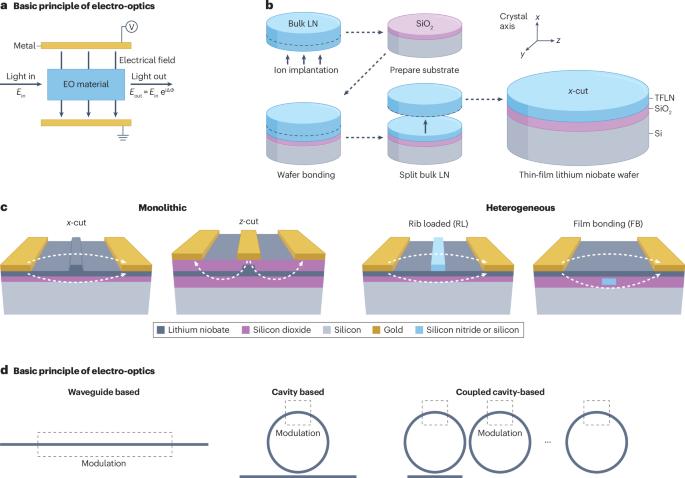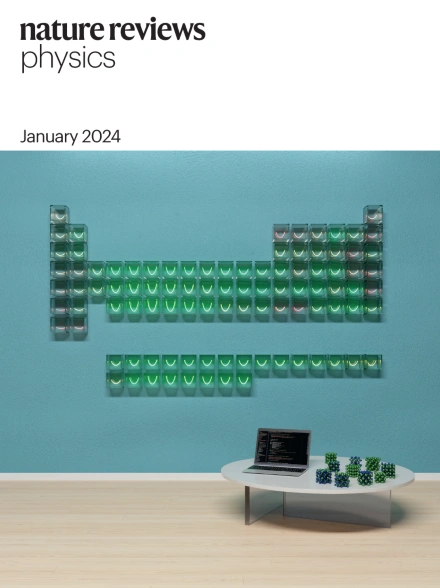薄膜铌酸锂的集成电光学
IF 39.5
1区 物理与天体物理
Q1 PHYSICS, APPLIED
引用次数: 0
摘要
电光学是电子学和光子学的桥梁,是从通信和计算到传感和量子信息的广泛应用的基础。特别是集成电光方法,在为电子学提供光子并行性的同时,为光子学提供了必要的电子高速控制。薄膜铌酸锂光子学的最新发展促进了其在电光学中的应用。该技术不仅提供了必要的强电光耦合,而且还提供了超低光损耗和高微波带宽。其严格的场约束和与现有纳米制造技术的兼容性允许出色的可重构性和可扩展性,有助于创建在批量系统中几乎不可能实现的设备和系统。在这个平台上,出现了各种新的电光设备1 - 16,它们超越了当前的艺术状态1 - 9,12 - 16,并引入了以前不存在的功能3,10,11。薄膜铌酸锂为探索各种物理领域提供了一个独特的平台,包括光子非厄米合成维度(17 - 19)、有源拓扑物理(20 - 21)和量子电光学(15 - 22-24)。在这篇综述中,我们介绍了电光的基本原理,并将基础科学与最新技术联系起来。我们讨论了利用薄膜铌酸锂平台实现集成光电的成就和前景。薄膜铌酸锂的强电光相互作用、低光损耗和高微波带宽使其从计算到量子信息的应用成为可能。本文综述了集成铌酸锂技术的基本原理、最新进展和未来潜力。本文章由计算机程序翻译,如有差异,请以英文原文为准。

Integrated electro-optics on thin-film lithium niobate
Electro-optics bridges electronics and photonics and serves as a foundation for a wide array of applications from communications and computing to sensing and quantum information. Integrated electro-optic approaches, in particular, enable essential electronic high-speed control for photonics while offering photonic parallelism for electronics. Recent developments in thin-film lithium niobate photonics have advanced its use for electro-optics. This technology offers not only the necessary strong electro-optic coupling but also ultralow optical loss and high microwave bandwidth. Its tight field confinement and compatibility with established nanofabrication techniques allow for excellent reconfigurability and scalability, aiding the creation of devices and systems that were deemed nearly impossible in bulk systems. Building on this platform, various new electro-optic devices1–16 have emerged, which surpass the current state of the art1–9,12–16 and introduce functionalities that previously did not exist3,10,11. Thin-film lithium niobate provides a unique platform to explore various areas of physics, including photonic non-Hermitian synthetic dimensions17–19, active topological physics20,21 and quantum electro-optics15,22–24. In this Review, we present the fundamental principles of electro-optics, drawing connections between fundamental science and state-of-the-art technology. We discuss the accomplishments and prospects of integrated electro-optics enabled by the thin-film lithium niobate platform. The strong electro-optic interaction, low optical loss and high microwave bandwidth of thin-film lithium niobate have enabled applications from computing to quantum information. This Review explores the fundamental principles, recent advances and the future potential of integrated lithium niobate technologies.
求助全文
通过发布文献求助,成功后即可免费获取论文全文。
去求助
来源期刊

Nature Reviews Physics
Multiple-
CiteScore
47.80
自引率
0.50%
发文量
122
期刊介绍:
Nature Reviews Physics is an online-only reviews journal, part of the Nature Reviews portfolio of journals. It publishes high-quality technical reference, review, and commentary articles in all areas of fundamental and applied physics. The journal offers a range of content types, including Reviews, Perspectives, Roadmaps, Technical Reviews, Expert Recommendations, Comments, Editorials, Research Highlights, Features, and News & Views, which cover significant advances in the field and topical issues. Nature Reviews Physics is published monthly from January 2019 and does not have external, academic editors. Instead, all editorial decisions are made by a dedicated team of full-time professional editors.
 求助内容:
求助内容: 应助结果提醒方式:
应助结果提醒方式:


